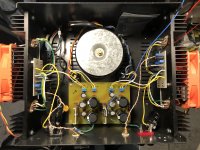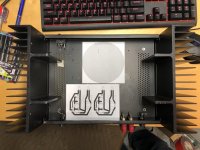I'm a little lost trying to determine what would be an adequate heatsink for a TIP2955 in my capacitance multiplier PSU.
This PSU was built based on a 2005 reading (or misreading) of Rod Elliot's project 36 Death of Zen back in 2005. I built it to try Class A but didn't really have a suitable speaker to pair it with until now.
The project page has since been updated and the PSU schematic shown does not quite match what I built but below is what I actually built, one for each channel.

It appears I halved C1/C2 in figure 6 since I made a PSU for each channel. I'm using a transformer with 2x25V secondaries.
Regarding Q1, the project page says, "Q1 and Q2 must be on a heatsink - dissipation will typically be about 16W for two channels (assuming 40V input and 35V output)."
The Project 15 A Simple Capacitance Multiplier Power Supply For Class-A Amplifiers page shows a dual supply layout with the addition of a diode and notes, "Dissipation in the TIP36 (or whatever you decide to use) will be around 6-7W with a current of 1.7A, so there's not a great deal of heat to get rid of in the heatsink."
Currently, I have a small piece of aluminum plate (1.5mm x 44mm x 47mm) bolted to Q1 to act as a heatsink and nothing on Q2. The aluminum plate stabilizes at 80C in the enclosure (17C ambient). Q2 is comfortably warm to the touch.
It seems like this temp is way too high. What would be a good target?
How could I determine the correct heatsink size that I could order?
I'm planning to etch a new PCB with a more space efficient layout so that I can more easily fit this project into a new donor chassis. At the moment, I'm stuck determining the footprint of a suitable heatsink for Q1.
This PSU was built based on a 2005 reading (or misreading) of Rod Elliot's project 36 Death of Zen back in 2005. I built it to try Class A but didn't really have a suitable speaker to pair it with until now.
The project page has since been updated and the PSU schematic shown does not quite match what I built but below is what I actually built, one for each channel.

It appears I halved C1/C2 in figure 6 since I made a PSU for each channel. I'm using a transformer with 2x25V secondaries.
Regarding Q1, the project page says, "Q1 and Q2 must be on a heatsink - dissipation will typically be about 16W for two channels (assuming 40V input and 35V output)."
The Project 15 A Simple Capacitance Multiplier Power Supply For Class-A Amplifiers page shows a dual supply layout with the addition of a diode and notes, "Dissipation in the TIP36 (or whatever you decide to use) will be around 6-7W with a current of 1.7A, so there's not a great deal of heat to get rid of in the heatsink."
Currently, I have a small piece of aluminum plate (1.5mm x 44mm x 47mm) bolted to Q1 to act as a heatsink and nothing on Q2. The aluminum plate stabilizes at 80C in the enclosure (17C ambient). Q2 is comfortably warm to the touch.
It seems like this temp is way too high. What would be a good target?
How could I determine the correct heatsink size that I could order?
I'm planning to etch a new PCB with a more space efficient layout so that I can more easily fit this project into a new donor chassis. At the moment, I'm stuck determining the footprint of a suitable heatsink for Q1.
Attachments
7 watts is not a huge amount of heat. It is also not trivial.
You can work out the size heatsink you need. If you are happy with a heatsink temperature of between 40 and 50C, say 20 degrees above ambient, you need a heagain of:
Say 10 watts for a 20C rise is 20/10 or a heatsink of thermal efficiency of 2 degC/W.
You will find this in the specs.
Or you can do the following... if you are laying out a board put the transistors right at the edge and use the case of the amplifier as a heatsink.
In my experience it is very useful to make an L bracket that you bolt to the chassis (With heatsink goo between the bracket and chassis) then use this as your heatsink. It will dissipate a LOT of heat
You can work out the size heatsink you need. If you are happy with a heatsink temperature of between 40 and 50C, say 20 degrees above ambient, you need a heagain of:
Say 10 watts for a 20C rise is 20/10 or a heatsink of thermal efficiency of 2 degC/W.
You will find this in the specs.
Or you can do the following... if you are laying out a board put the transistors right at the edge and use the case of the amplifier as a heatsink.
In my experience it is very useful to make an L bracket that you bolt to the chassis (With heatsink goo between the bracket and chassis) then use this as your heatsink. It will dissipate a LOT of heat
.....plate stabilizes at 80C in the enclosure (17C ambient). ....It seems like this temp is way too high.....
Did you read the '2955 datasheet? The *junction* can go to 150 °C operating. With your small heatsink the temp drop junction to sink is smaller than the temp drop sink to air. Your junction is not a lot hotter than 60°C, maybe 90°C. This is rated safe. A commercial designer sure would work it that hot.
Is this load class AB or A? In class AB with thump-a-thump music running hotter and cooler every second, 50°C is a much safer limit to reduce thermal cracking. In steady-load class A work, or a load that varies slowly, you can go significantly hotter.
Since you have not given your observed working voltage and current, any sink suggestion would be mostly guesswork or habit.
As a matter of interest, all heat sinks have a specification and the specification denotes the dissipation of heat from a power source.
If you disregard the thermal property of the components you wish to keep cool, firstly find out the power, in this case say 10 Watts. Find the maximum operating temperature of the device, usually 70℃, so you are looking at a heatsink large enough to do the job.
If your heatsink is rated at 2.5º per Watt then multiply the power (10) by the dissipater (2.5) and you get 25.
That means it will run at 10Watts at an average temperature 25º above ambient or room temperature.
If the heatsink is 1.1º per Watt then the result will be 11º above ambient temperature.
Hope that explains it for you.
If you disregard the thermal property of the components you wish to keep cool, firstly find out the power, in this case say 10 Watts. Find the maximum operating temperature of the device, usually 70℃, so you are looking at a heatsink large enough to do the job.
If your heatsink is rated at 2.5º per Watt then multiply the power (10) by the dissipater (2.5) and you get 25.
That means it will run at 10Watts at an average temperature 25º above ambient or room temperature.
If the heatsink is 1.1º per Watt then the result will be 11º above ambient temperature.
Hope that explains it for you.
TO218 case gives possibility to place it almost anywere.
it occurred to me this morning that I could move C1/C2 off the PCB so I could shrink that PCB further to make it easier to get it close to the heatsinks.
Could I mount Q1 on the heatsink away from the PCB? If so how long could the wires back to the PCB be?
I would place Q1, Q2 on the same heater as the main amp.
Best regards!
- Status
- This old topic is closed. If you want to reopen this topic, contact a moderator using the "Report Post" button.
- Home
- Design & Build
- Construction Tips
- help needed with TIP2955 heatsink in capacitance multiplier psu


